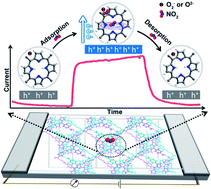Organic small molecule semiconductor (OSMS) microporous crystals with strong π–π interactions are rare but have great potential in applications requiring both excellent mass and charge transport. To obtain such a microporous structure, effective molecule design and control over the packing of the OSMS are necessary but still challenging. Herein, we report three meso-tetrakis (4-carboxyphenyl) porphyrin (TCPP) based porous OSMS materials, 1, 2 and 3, whose porosity and π–π interactions among TCPPs were modulated by varying the H-bonding linkage nodes. The relationship among the hydrogen bonding structure, packing mode and sensing performances has been carefully studied. With the largest overlap between porphyrin rings and strongest face-to-face π–π interactions in the prepared compound, 1 showed the best performances. Moreover, it also represents the first RT NO2 chemiresistive sensing material that simultaneously achieved an experimental limit of detection as low as 20 ppb and a time of recovery as short as 0.6 min. This work revealed the key role of H-bonding linkage node in constructing a microporous OSMS and provides a new type of high-performance rt chemiresistive gas sensing material.

